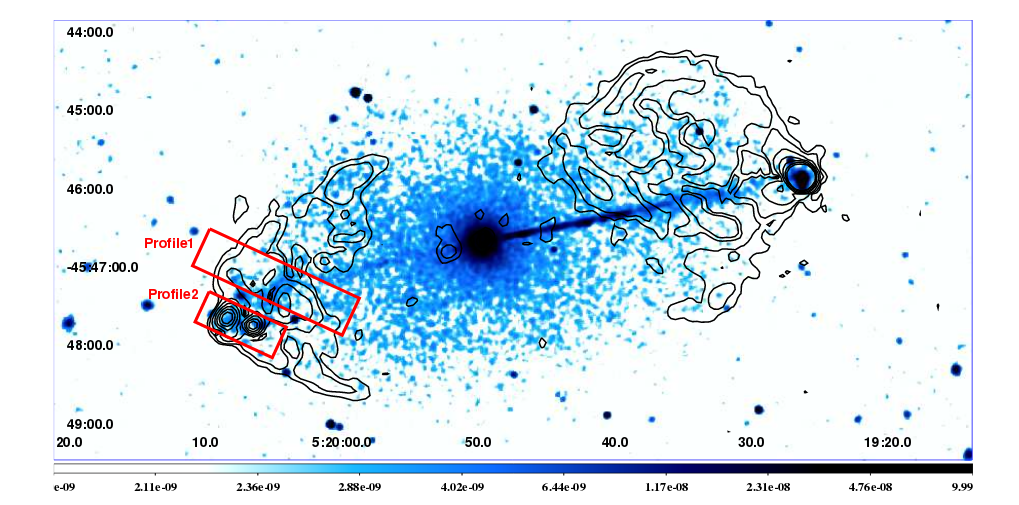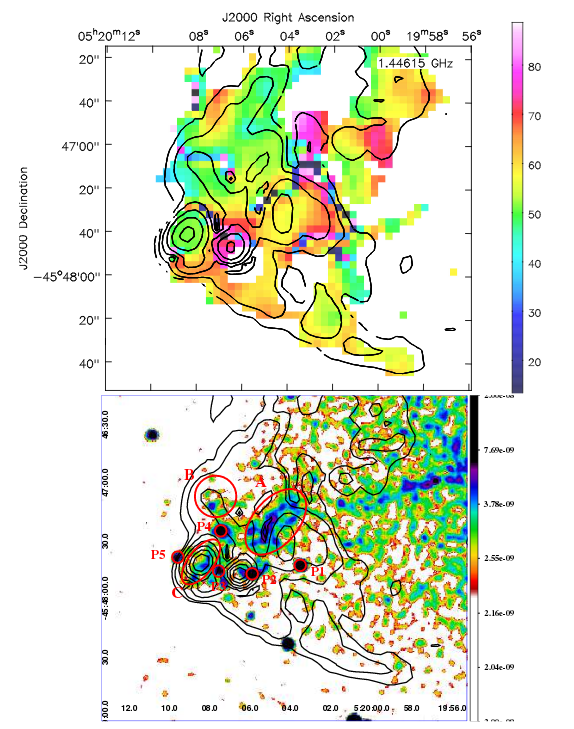Astronomy Object of the Month: 2021, October
< previous Archive next >
Complex Structure of the Eastern Lobe of the Pictor A Radio Galaxy
Pictor A, classified as a Broad-Line Radio Galaxy with the
“classical double” (Fanaroff-Riley
type II) large-scale radio morphology and located at the redshift z=0.035, is one of the most
prominent radio galaxies in the sky and the prime target for detailed multiwavelength investigations
in the recent decades, from radio to the X-ray ranges. Now, JU astronomers present the detailed
analysis of the distinct X-ray emission features present within its Eastern radio lobe utilising
the data obtained from the
Chandra X-ray Observatory.

Illustration 1: The 0.5–7.0 keV merged
Chandra image of the entire structure of Pictor A, smoothed with 3σ Gaussian radius, with the 1.45 GHz VLA total
and polarized intensity (3σ) contours superimposed (red and white, respectively). The two elongated yellow
rectangles denote the areas across the high-polarization regions of the Eastern lobe, for which the team
extracted the surface brightness profiles at X-ray and radio frequencies. Image credit: The Authors.
The large-scale radio and X-ray jet in
Pictor A originates in the galaxy nucleus and extends up to hundreds of kilo parsecs beyond the host
galaxy to the West. The so-called counter-jet is not prominent at radio waves, but can be easily spotted
in deep X-ray maps by the Chandra Observatory. The
hotspots, located at both sides of the core at the lobes’ edges, mark the termination points of the
jets to the West and East. The bright Western hotspot is clearly detected and even resolved at radio,
infrared, optical and X-ray frequencies. The
radio lobes appear in X-rays as a low-surface brightness cocoon surrounding the large-scale structure
of the jets.
Extended lobes in radio galaxies, formed as backflows when the jet plasma passes through the termination shock and is turned away at the contact discontinuity between the shocked outflow and intergalactic medium, are particularly prominent at radio frequencies, due to the synchrotron emission of ultra-relativistic electrons. While the detailed radio studies of the lobes with the arcsecond angular resolution often reveal a complex morphology with filamentary structures, their X-ray observations, carried out with modern instruments such as Chandra, allowed to resolve the lobes and detect the emission consistent with a non-thermal power-law continuum. Lobes are expected to be extremely low-density but high-pressure envelops surrounding (and also confining) the jets, believed to be filled solely by ultra-relativistic electrons and magnetic field, with the total internal energy equal to that of the jet bulk kinetic energy. However, several observational findings have recently been reported on large amounts of a thermal gas also present in the lobes, providing a prominent contribution to their X-ray radiative output and the pressure balance.
In the recent paper, JU scientists analyzed the archival Chandra data for the extended lobes of Pictor A, focusing on the Eastern (E) lobe and the complex E – hotspot region. The X-ray maps of these targets were compared in detail with various radio maps of the regions, obtained with the Very Large Array (VLA) radio interferometer.

Illustration 2:
Top: A zoomed view of the rotation measure
distribution within the E hotspot region in Pictor A, with the polarized intensity L band contours superimposed.
Contours start from 3σ confidence level and are scaled by √2. Bottom: A zoomed view of the 0.5–7.0 keV emission of
the E hotspot region in Pictor A, with the 1.45 GHz polarized intensity contours (black) superimposed. The Chandra
image is smoothed with 3σ Gaussian (radius 5 px). Radio contours start from 3σ confidence level. Regions selected
for the Chandra data analysis are labeled and indicated by red contours. Credit: The Authors.
The obtained images and results reveal some interesting features. First of all, the double structure of the hotspot is prominent in both total radio intensity and polarized radio intensity maps. So-called ‘secondary’ hotspot (the most prominent and outermost radio feature to the East) coincides with some enhancement in the diffuse X-ray emission, but nonetheless appears dramatically weaker at keV photon energies than the Western hotspot, placed on the other side of the nucleus. There are also several bright compact X-ray sources in the closest vicinity of the double E hotspot, but none of which coincides with the peaks of either total or polarized radio intensity. For the spectral analysis, the team selected four such distinct regions. On the polarized radio intensity maps, all of these happen to be located almost exactly at the edges of the hotspot’s double structure. Moreover, one of the bright compact X-ray sources (P5) lies well outside the radio emission on high-resolution maps.
A relation of point-like X-ray features with no optical counterparts to the radio lobes and hotspot regions of radio galaxies and radio quasars is unclear and subjected to speculations. Such features may simply be background AGNs, unrelated to the observed radio lobe, but may also result from various energy dissipation processes taking place within the lobes with complex magnetic field structure. For example, if the lobes’ radio filaments represent indeed tangled magnetic field tubes, then at the places of the filaments’ interactions with density or magnetic enhancements in the surrounding plasma, localized multiple compact sites of violent reconnection may form, loading turbulence and thus enabling efficient particle acceleration as well as plasma heating.
However, the main findings following from this Pictor A analysis regard the elongated X-ray filament A, located upstream of the jet termination region and extending for at least 30 kpc. Its 0.5–7.0 keV radiative output is consistent with a pure power-law emission, or alternatively a combination of a flat power-law component and a thermal plasma. In the former case, the X-ray slope would be consistent (within the errors) with the slope of the radio continuum at the position of the filament. The latter case would be, on the other hand, in accord with recent findings of a larger amount of a thermal gas possibly present within the radio lobes of radio galaxies.
Original publication: R. Thimmappa, Ł. Stawarz, U. Pajdosz-Śmierciak, K. Balasubramaniam, V. Marchenko, Complex Structure of the Eastern Lobe of the Pictor A Radio Galaxy: Spectral Analysis and X-ray/Radio Correlations, 2021, [astro-ph.HE].
The research was conducted at the Department of High Energy Astrophysics of the Jagiellonian University’s Astronomical Observatory (OAUJ). This research has made use of data obtained from the Chandra Data Archive. The work was supported by the PolishNSC grant 2016/22/E/ST9/00061.
|
Rameshan Thimmappa Astronomical Observatory Jagiellonian University R.Thimmappa [at] oa.uj.edu.pl |


